Back in the summer of 2015, as a huge fan of Irina Gorin’s YouTube channel, I attended Irina Gorin’s first ever piano teacher workshop held near her hometown in the Indianapolis area. Here is a photo of Irina and I during the workshop.

Over the past two years, I have been using Irina’s self-published method book, “Tales of a Musical Journey”, more and more with my students. As I have become more familiar with the books and am seeing its results in my students, it has become my favorite piano method book.
If you’ve watched any of Irina’s teaching videos on YouTube, you have seen for yourself how Irina successfully develops in her students a healthy physical approach the instrument as well as expressive and sensitive playing — even in her youngest beginner students. Irina’s books are the result of combining what she feels is the best of Russian piano pedagogy and the best of American piano pedagogy. This makes Irina’s method unique and quite different from typical American piano method books.
In this article, I’d like to share an overview of Irina’s method and the reasons why I like it so much.

Book 1 – Tales of a Musical Journey

“Tales of a Musical Journey” consists of just two levels, each consisting of a single all-in-one book: Book 1 and Book 2. Book 2 is designed to lead directly into Late Elementary level repertoire. Irina says she will never write a Book 3. I love the simple elegance of this!
“Tales” uses a story-based approach. Each chapter of the book introduces musical concepts and skills through a story involving characters and events within the “magical kingdom of sounds”. Sometimes, I choose to just summarize the stories during lesson time, assigning students to read them in their entirety at home — but usually I take the time to read aloud the chapter’s entire story. The learning is within the story, after all. And the stories make the learning memorable.
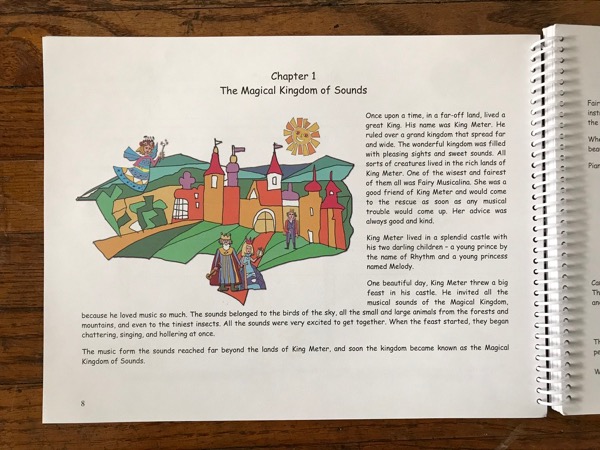
Book 1 begins with a gradual introduction to playing the piano, while focusing on developing freedom and flexibility of all upper body parts: shoulders, arms, wrists, and fingers; and on developing awareness of pulse and basic rhythm values.
The early pieces in Book 1 require students use only finger 3. This is a major point of departure from typical American method books, which from the beginning require students to use all five fingers in a so-called “5-finger position” — which to a child’s hand, Irina points out, is equivalent to an adult hand stretching open across seven or eight keys. It is challenging to develop a comfortable way of playing while the hand is stretched open, so Irina deftly avoids the issue by allowing time for students to play using only finger #3 before gradually adding other fingers. This enables students to develop comfortability with the large muscle movements required press and release the keys with a beautiful tone and without excessive tension. Fingers 1 and 5, the more awkward fingers, are added towards the end of Book 1.

On a related note: Irina believes in developing non-legato touch before legato or staccato. Book 1 is devoted exclusively to non-legato playing.
Technique development in Irina’s method is not only sequenced brilliantly, but it is embedded into the way the pieces are composed. The pieces are composed around the emerging technical and musical skills that are most comfortable for a child’s hand. There is no need for a separate technique book.
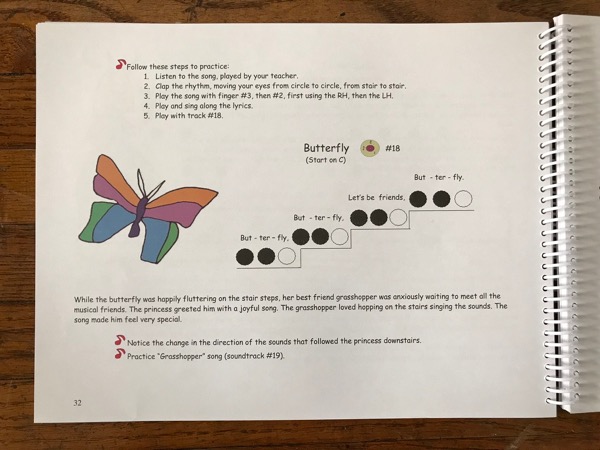
Rhythm skills are first addressed through activities that build awareness of pulse at various tempos: clapping, marching, chanting poems, and playing along with accompaniment on the CD. Rhythm notation is taught through the use of black and white circles, representing short and long durations, before traditional rhythm notation is introduced. (See this blog post for more on using black and white circles for rhythm games.)

Staff notation is introduced beginning with Middle C and gradually moving outwards into the treble clef and bass clef. However, this is not a typical American “Middle C approach” that carries the potential pitfall of becoming reliant on a “Middle C position”. In “Tales”, students become comfortable playing anywhere on the keyboard the piece requires. In fact, already in Book 2 they are comfortable shifting across the keyboard during pieces.
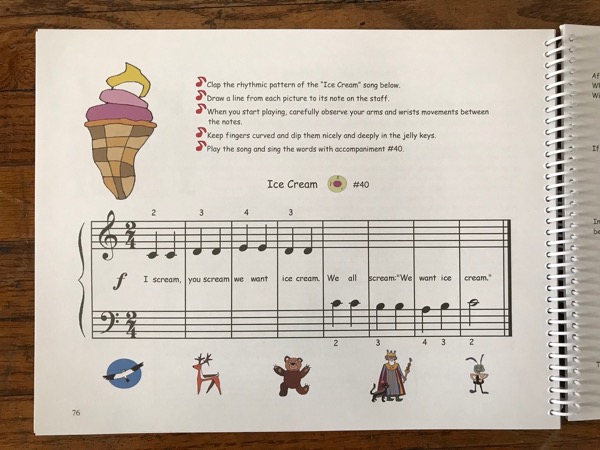
By the end of Book 1 (100 pages in length), students can read and play simple pieces, in duple or triple meters, that use basic rhythm values and pitches between Bass G and Treble F.
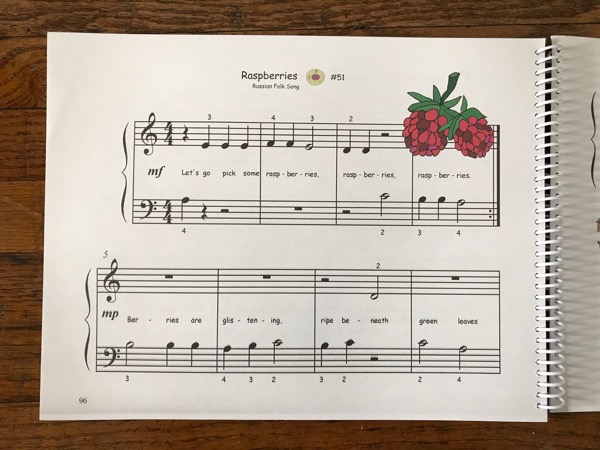
Book 2 – Tales of a Musical Journey

As much as I love Book 1, I love Book 2 even more. The pieces are charming, with varying moods and styles. The pieces contain many articulation markings (prompting non-legato, legato, and staccato touch) — far more than typical piano methods do at this level — requiring students to learn early on to pay close attention to detail.
Book 2 begins with two non-legato pieces before introducing two-note slurs for the first time. Once students experience success with legato with two-notes slurs, they are given three-note and four-note slurs. Staccato is introduced half-way through the book. Other music notation symbols introduced include accidentals, dynamic markings, ties, and eighth notes.
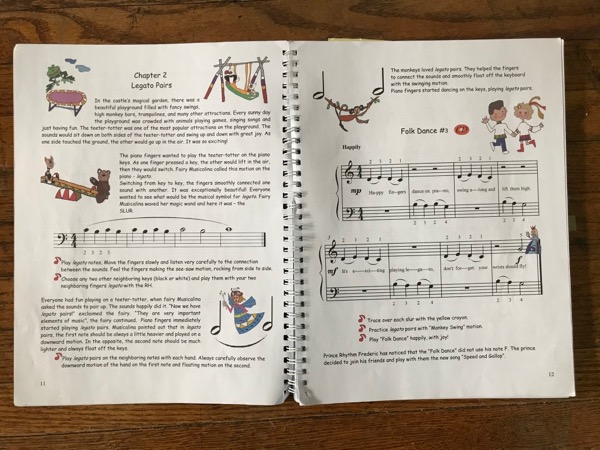
I have found additional use for Book 2 apart from after Book 1. Book 2 is perfect for transfer students or any students who tend for example to play with a level of unnecessary tension, miss articulation markings (slurs, staccato, shaping phrases, etc.), or are uncomfortable moving across the keyboard during the course of a given piece. I have given Book 2 to students of mine who completed early levels in other method book series but who, I noticed, did not have the same ease in their playing approach or attention to detail as my “Tales” students. In those cases, I combined or replaced their other books with “Tales” Book 2 and de-emphasized the built-in storyline, which continues from where Book 1 left off. I was delighted with the results. Book 2 is a go-to resource in my teaching.

By the end of Book 2, students are playing Late Elementary level pieces and are ready for their first classical repertoire. From here, I recommend any book of easiest classical piano literature or a choice anthology of Late Elementary repertoire, such as my recent personal favorite: the Celebration Series’ Preparatory A book.
Closing Comments
There is a learning curve when it comes to teaching with “Tales”. Teachers who are accustomed to the approach of typical American method books will need to learn to adjust the differences. In my experience, the investment is worthwhile. Learning how to use Irina’s “Tales” has opened my eyes to more effective learning sequences — particularly for piano technique — and made me a better teacher.
If you are a regular reader of my blog, you’ll know that in recent years I’ve been quite interested in Music Learning Theory (MLT). Although Irina’s method was not intended to follow principles of MLT, my opinion is that her method allows more room for MLT melding than typical American methods do.
Despite being an interminable experimenter with piano methods books, I have a feeling Irina’s “Tales of a Musical Journey” is bound to remain a core favorite of mine for years to come.
Learn:
If you are interested in learning from Irina’s approach, I recommend subscribing to her YouTube channel here. Secondly, if you have opportunity, I highly recommend attending her workshop for piano teachers. There is much to learn from Irina that is not covered in her books. This summer (2018), Irina is giving only one U.S. appearance due to being in such high demand in Asia this year. Registration information is here.
Here is a link to some printables I created after attending Irina’s workshop.
If you decide you’d like to try using Irina’s books with your students, you’ll be happy to see this Google Spreadsheet created to correlate pages from the books to related teaching videos from Irina’s channel. So helpful!
In addition, you’ll want to request to join the facebook group Irina administers to support teachers who are using her books. You can request to join here.
Purchase:
Tales of a Musical Journey is available on Irina’s site and on Amazon.com:
- Purchase Book 1 directly from Irina’s site or at Amazon.
- Purchase Book 2 directly from Irina’s site or at Amazon.
- Browse her other materials, including a Guidebook for Teachers, Supplemental Kit containing props, the CDs of accompaniment tracks (I have these loaded on my iPad to use during lessons), a Christmas book, and more.
Thanks for reading my review! I hope you’ll consider checking out Irina’s “Tales of a Musical Journey”.


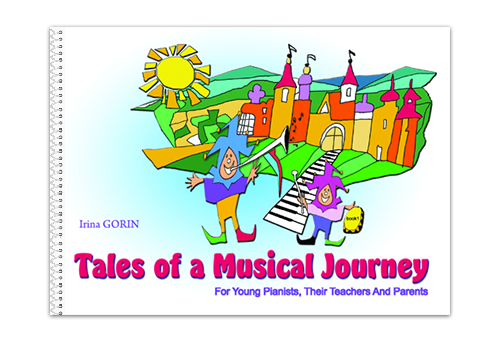
Thanks Joy for all your informative posts! I usually find the, refreshing and helpful. Irina’s method is very intriguing. The way she introduces the staff ( outwards from middle C on both clefs) is exactly like my current favorite method book, but I am now thinking about “borrowing” her one finger approach for a student who seems to struggling with grasping everything all at once.
I’d definitely encourage you to give the “one finger” approach a try to see what you think!
Wonderful! If only I could have been taught by Irina or you Joy, when I was younger!
This is very interesting Joy and I am intrigued. With young beginners I prefer Janet Vogt/Leon Bakes Piano Discoveries to my usual Faber. I am very intrigued with this method. Thank you for all your wonderful information!!!
I’m glad you found this interesting, Pamela! Thanks for reading!!
So glad to see this review pop up- someone else just mentioned this method to me last week and I’ve been curious about it ever since. Do you have a good sense for what age range it’s appropriate for? I’m in the market for books to use with preschool age beginners right now
Hi Valerie! Irina uses her books not infrequently with students as young as age four. I think at times she has even worked with age three. Be sure to check on her YouTube channel: I think you’ll find examples there. Personally, I would recommend getting familiar with Irina’s books with slightly older beginners (age 5-7) before trying it with age four. I do think it could be an excellent resource for that age group once the teacher is comfortable with the approach!
Thank you!
Hi Joy, thank you for an excellent review! I am wondering if you could share how you combine using MLT and Irina’s books please?
Good question! In short: I am doing my best to incorporate more away-from-the-piano listening and movement activities that build their readiness for understanding what they hear (“audiation”). I sing or chant a rhythm “song” and ask them to listen and move in a way that explores flow, weight, space, and time, and later. Then I might also ask them to copy my model of moving to macrobeats and microbeats, or singing what we hear to be the resting tone. We echo short rhythm patterns and tonal patterns (2-4 tones) to build their “music vocabulary”. Students are led to recognize when they hear duple meter, triple meter, or something else and when they hear sets of tones as being in major, minor, or something else.
I appreciate that Irina’s compositions are not as five-finger based as typical piano methods, not only for technical development reasons as I discussed in my review, but also because it means the pieces are not so centered around scale degrees 1-2-3-4-5 at the expense of the other tones in a given tonality. Also, her book uses minor tonality more often than typical piano methods. Variety is a good thing because Gordon says we learn through differences, not sameness!
Thanks Joy for your very thorough review of this book by Irina. I would love to attend one of her workshops!! The you tube videos are helpful however. There are so many new methods popping up all the time that it can be overwhelming and confusing. But I am interested in her approach.
I know you have studied many methods recently, and I’m curious what others besides Tales that you are currently using. Would you mind sharing?
Hi Saundra! Yes, there are so many methods to choose from! It can be overwhelming. I generally try to familiarize myself with just one new-to-me method each year. I’ve learned valuable things from every method I’ve used.
My oldest favorite is Faber. Others I have enjoyed include Celebrate Piano, Piano Pronto, and Piano Safari. Tales of a Musical Journey is my current obsession. I’m beginning to familiarize myself with Music Moves for Piano (an MLT-based method). I’d like to experiment with Hello Piano! at some point in the future.
Thank you for the great review! I’ve been researching method books for very young beginners and thought “Tales” might be a good one. I’m also anxiously awaiting my copy of “Music Moves.” I’d love to hear your thoughts on “Music Moves,” too, when you’re ready!
So insightful and helpful! Thank you Joy!